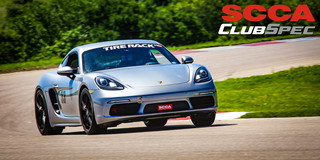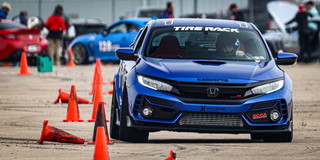
This article first appeared in the September, 2015 edition of SportsCar Magazine. SCCA members can read the current and past editions of SportCar digitally here after logging into their account; To become an SCCA member and get SportsCar mailed to your home address monthly in addition to the digital editions, click here.
In RallyCross, correct tire selection is second only to seat time. So, how do you know which tires are right for you?
The old adage of investing in quality tires holds true in just about any motorsport – especially RallyCross. A great RallyCross car with poor tires is a poor car, and a poor car with the best tires can shock the whole field. Tires, after all, have the most effect on grip, and grip is the number one thing you can never have too much of in Rallycross. But picking the correct RallyCross tire is not always a simple matter.
Complications in this regard start early in RallyCross. In the case of rear-wheel or front-wheel drive, the driven wheels may need a different tire than the non-driven wheels, and tire choices are limited by class. In Stock, you can only run DOT-approved tires; competition rally tires are prohibited. You also cannot modify the tread pattern by cutting on the tire, and studs (street legal, not home made) are allowed for ice and snow events only. When you move up to Prepared or Modified classes, rally tires are allowed, although this does not include ATV tires. Those are the basics – let’s dive a little deeper.
A Pattern for Victory
In general, how aggressive a tread pattern is, is related to the amount of open area (grooves) to the overall tire contact patch. The more open area, the more aggressive the tire. Tread may also be directional and may even have a specific “outside,” both of which will be noted on the sidewall.
Tread is a series of blocks and grooves. As the grooves get wider, clumps of material get heavier and act together to pull away from the tire as it spins. In mud or soft dirt – and even grass – this becomes very important.
The ratio of open area (grooves) to surface area (blocks) is a delicate balance. On harder ground, more contact gives better grip; in muddy conditions, larger open areas enable the tire to throw off the debris and dig down deep to find traction. Finding the best ratio of block and groove area for a given soil density is the key.
Sidewall construction is extremely important in RallyCross. Stiffer sidewalls are preferred in this sport in order to reduce tread deflection and reduce the chance of damage from rocks or de-beading. Rally tires, therefore, have much stiffer sidewalls than DOT tires and can run with lower pressures.
Stock class vehicles often use snow tires, as those tires have an aggressive tread. Some favorites in this category include the Firestone Winterforce, Bridgestone Blizzak, Dunlop Winter Maxx, and the Goodyear Ultra grip (with or without studs).
Modified and Prepared classes have the luxury of rally tires in addition to DOT. Rally tires are usually heavier than a DOT, but are also more durable – they’re also very hard to find in diameters other than 13, 14, and 15 inches. While it’s often challenging to find them for sale in the U.S., common rally tires include the Yokohama A031, A034, and A035. Companies like Kuhmo, D-Mack, Michelin, BFGoodrich, Maxxis, Dunlop, Hankook, Silverstone, Bridgestone, and Pirelli also offer rally tires.
Weapon of Choice
Reading the RallyCross course in the morning and throughout the day as the surface changes is key to selecting the right tire. That said, having a selection of tires at an event may be beyond most budgets, especially when rally tires cost more than $250 each. Regardless, taking note at one event may help with your next tire purchase.
On your course walk, look for the worst part of the course. That will either be the soft, muddy turn, or the very hard packed one with loose gravel. Remember, grass hides moisture. Use your heel, fingers – or even your keys – to find out how deep the surface is and what’s beneath. As the day progresses, if the harder surface below starts to appear, try switching to a less aggressive tire. If it looks like rain is coming, a more aggressive tire would be handy. Remember, swapping tires in the grid between runs is tricky, so have all the tools you’ll need handy.
A “pro” tip for those on a budget in a two-wheel-drive class is to buy two of each type of tire you think you’ll need and then swap the best set for traction on the drive wheels, leaving the other two for the non-driven wheels.
Tricks of the Trade
Driving in mud requires you to keep the tires spinning, cleaning out the grooves. Don’t be shy, but watch the revs. Also, watch the temperature gauge. In gravel, you can spin a bit, but you want to be on the threshold of traction. On snow, you’ll see the use of narrower tires to dig in. Studs are great for ice, but contrary to popular belief, they don’t have much of an effect on other surfaces.
Also note that winter snow and ice tires are constructed of compounds designed to stay flexible at lower temperature, while most rally gravel and mud tires turn into hard plastic below 40 degrees F. Meanwhile, studded tires require about 1,000 miles of driving to seat the studs and bed them into the rubber – if you don’t, they can pull out when used aggressively.
With that said, nothing replaces good old-fashioned seat time and research. If you’re trying to decide which tires are the best for you and your car, compete on what you have, but talk to your fellow competitors and get their opinions – and, more importantly, see what tires the winners are using. Combine all of this knowledge, and it just might be your time to take the win.
Words by Leon Drake, with help from Chang Ho Kim
Image by iStockPhoto.com/GregAIT










